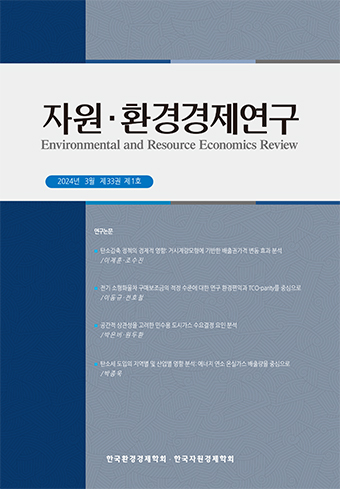Research Paper
Abstract
References
Information
The fine-dust season management system refers to the policy of implementing enhanced reduction measures in transportation, power, business and living sectors in winter, when fine dust levels are high. The fine dust season management system is a regulatory policy that causes social costs and transfers to various economic players. Equity is an important issue for the cost burden. Therefore, in this study, the cost of each power generator was analyzed using the coal power generation reduction amount of each power generator to verify that the cost of the power sector is evenly distributed. In particular, the effect of the fine dust season management system on coal power generation of power generators was analyzed by applying a synthetic control method that can identify the time-variable effect of the policy. It was confirmed that the fine dust season management system reduced volume of fuel and power generation in coal power plants, resulting in an increase in the cost of the power generation sector, even considering the effect of some power demand due to the COVID-19 crisis. However, it could be seen that these costs were not distributed equally among the generators, and that they were more costly to the specific generators.Social costs incurred by fine dust season management need to be improved so that stakeholders are equally burdened.
미세먼지 계절관리제는 미세먼지 고농도 시기인 겨울철에 수송, 발전, 산업, 생활 부문에서 강화된 저감 조치를 시행하는 정책을 말한다. 미세먼지 계절관리제는 규제정책으로 사회적 비용을 발생시키고, 다양한 경제주체에게 전가가 된다. 비용부담에 있어서 형평성은 중요한 문제이다. 따라서 본 연구에서는 발전 부문의 비용이 균등하게 배분되는지 확인하기 위해 각 발전사의 석탄발전 저감량을 이용해 발전사별 비용을 분석하였다. 특히, 정책의 시간가변효과를 파악할 수 있는 합성대조법을 적용해 미세먼지 계절관리제가 발전사의 석탄발전량에 미치는 효과를 분석하였다. COVID-19 사태로 인해 일부 전력 수요가 감소한 효과를 감안하더라도 미세먼지 계절관리제가 석탄발전소의 연료 사용량, 발전량을 감소시켜 발전 부문의 비용 증가가 나타나는 것을 확인할 수 있었다. 그러나 이러한 비용은 발전사별로 균등하게 배분되지 않고, 특정 발전사에 가중되는 것을 확인할 수 있었다. 미세먼지 계절관리로 인해 발생하는 사회적 비용이 이해관계자들에게 형평성 있게 부담되도록 개선할 필요가 있다.
- 국가기후환경회의, “국가기후환경회의 중장기 국민정책제안”, 2020. 11.
- 남기표‧이대균, 이재범, 최기철, 장임석, 최광호, “효율적인 대기정책 마련을 위한 대기질 모델 활용방안 고찰: 노후 석탄화력발전소 가동중지에 따른 충남지역 PM 2.5 저감효과 분석을 중심으로”, 「한국대기환경학회지」, 제34권 제5호, 2018, pp. 687~696. 10.5572/KOSAE.2018.34.5.687
- 박순애‧신현재, “한국의 초미세먼지 (PM 2.5) 의 영향요인 분석: 풍향을 고려한 계절성 원인을 중심으로”, 「환경정책」, 제25권 제1호, 2017, pp. 227~248.
- 박호정‧홍종호, “수도권 운행차 대기오염 저감사업의 효과: 실물옵션분석”, 「자원· 환경경제연구」, 제23권 제3호, 2014, pp. 435~451.10.15266/KEREA.2014.23.3.435
- 이동규‧성재훈, “노후 석탄화력발전소 가동중단에 따른 발전소 주변지역의 초미세먼지 농도 감소효과 분석”, 「자원· 환경경제연구」, 제27권 제2호, 2018, pp. 315~337.
- Abadie, A., A. Diamond, and J. Hainmueller, “Synthetic control methods for comparative case studies: Estimating the effect of California’s tobacco control program,” Journal of the American statistical Association, Vol. 105, 2010, pp. 493~505.10.1198/jasa.2009.ap08746
- Abadie, A., and J. Gardeazabal, “The economic costs of conflict: A case study of the Basque Country,” American economic review, Vol. 93, 2003, pp. 113~132.10.1257/000282803321455188
- Chiesa, M., M. G. Perroneb, N. Cusumanoc, L. Ferrerob, G. Sangiorgib, E. Bolzacchinib, A. Lorenzonic, and A. Ballarin Denti, “An environmental, economical and socio-political analysis of a variety of urban air-pollution reduction policies for primary PM10 and NOx: The case study of the Province of Milan (Northern Italy),” Environmental science & policy, Vol. 44, 2014, pp. 39~50.10.1016/j.envsci.2014.07.012
- Doudchenko, N., and G. W. Imbens, Balancing, regression, difference-in-differences and synthetic control methods: A synthesis, National Bureau of Economic Research, 2016.10.3386/w22791
- Gharehgozli, O, “An estimation of the economic cost of recent sanctions on Iran using the synthetic control method,” Economics Letters, Vol. 157, 2017, pp. 141~144.10.1016/j.econlet.2017.06.008
- He, X., and S. Jiang, “Effects of vehicle purchase restrictions on urban air quality: Empirical study on cities in China,” Energy Policy, Vol. 148, 2021.10.1016/j.enpol.2020.112001
- Jia, R., and H. Ku, “Is China's pollution the culprit for the choking of South Korea? Evidence from the Asian dust,” The Economic Journal, Vol. 129, 2019, pp. 3154~3188.10.1093/ej/uez021
- Jung, M. C., J. Park, and S. Kim, “Spatial relationships between urban structures and air pollution in Korea,” Sustainability, Vol. 11, 2019, pp. 476.10.3390/su11020476
- Kreif, N., R. Grieve, D. Hangartner, A. J. Turner, S. Nikolova, and M. Sutton, “Examination of the synthetic control method for evaluating health policies with multiple treated units,” Health economics, Vol. 25, 2016, pp. 1514~1528.10.1002/hec.325826443693PMC5111584
- McClelland, R., and S. Gault, The synthetic control method as a tool to understand state policy, Washington, DC: The Urban Institute, 2017.
- Mori, I, M. Nishikawa, T. Tanimura, and H. Quan, “Change in size distribution and chemical composition of kosa (Asian dust) aerosol during long-range transport,” Atmospheric Environment, Vol. 37, 2003, pp. 4253~4263.10.1016/S1352-2310(03)00535-1
- Nordhaus, W., “Climate change: The ultimate challenge for economics,” American Economic Review, Vol. 109, 2015, pp. 1991~2014.10.1257/aer.109.6.1991
- Peri, G., and V. Yasenov, The labor market effects of a refugee wave: Applying the synthetic control method to the Mariel boatlift, National Bureau of Economic Research, 2015.10.3386/w21801
- Publisher :Environmental and Resource Economics Review
- Publisher(Ko) :자원 · 환경경제연구
- Journal Title :자원·환경경제연구
- Journal Title(Ko) :Environmental and Resource Economics Review
- Volume : 30
- No :4
- Pages :627-648
- DOI :https://doi.org/10.15266/KEREA.2021.30.4.627



 자원·환경경제연구
자원·환경경제연구






